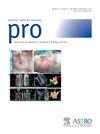Metastatic-Site Radiation Therapy for Ewing Sarcoma and Rhabdomyosarcoma: Consensus Guidelines From the National Pediatric Cancer Foundation
IF 3.5
3区 医学
Q2 ONCOLOGY
引用次数: 0
Abstract
Purpose
Despite the urgent need for improved outcomes in patients with metastatic Ewing sarcoma (EWS) and rhabdomyosarcoma (RMS), it is unknown how to best approach metastatic-site radiation therapy for these patients and whether such treatment provides a significant oncologic benefit that outweighs the toxicities.
Methods and Materials
We gathered a panel of pediatric radiation oncologists from academic hospitals to identify and discuss current controversies regarding the role of radiation in the management of metastatic EWS and RMS. The panel reviewed existing clinical data and ongoing trials to address 5 key questions: (1) the role of whole lung irradiation (WLI) in treating lung metastases; (2) the number of metastatic sites warranting radiation therapy and the radicality of such an approach; (3) radiation techniques, including stereotactic body radiation therapy (SBRT); (4) the timing of metastatic-site radiation therapy; and (5) the utility of metastatic-site radiation therapy for relapsed metastatic disease.
Results
After a review of existing data, consensus recommendations were developed to support the decision-making process in metastatic-site irradiation, aiming to improve long-term disease control. Patients with pulmonary metastases should receive WLI. In patients with limited (<8 sites) metastatic disease, a comprehensive approach should be taken to treat all sites of metastatic disease diagnosed at presentation. SBRT should be considered as a preferred treatment technique. The timing of metastatic-site treatment should coincide with the end of systemic therapy. However, if there is a dosimetric advantage or improved compliance, concurrent treatment with the primary site may be preferred.
Conclusions
A consensus guideline was established to address several critical questions regarding the role of radiation in the treatment of metastatic EWS and RMS. The study highlights the existing controversies, provides a structured approach, and underscores the need for future studies to further evaluate the therapeutic ratio of metastatic-site directed therapy.
尤文肉瘤和横纹肌肉瘤的转移部位放射治疗:全国儿童癌症基金会共识指南》。
背景:尽管转移性尤文肉瘤(EWS)和横纹肌肉瘤(RMS)患者急需改善治疗效果,但如何对这些患者的转移部位进行最佳放射治疗,以及这种治疗是否能带来明显的肿瘤学益处,从而使其毒副作用大于治疗效果,这些问题仍不得而知:方法:我们召集了一个由来自学术医院的儿科放射肿瘤专家组成的小组,以确定和讨论目前有关放射治疗在转移性 EWS 和 RMS 治疗中的作用的争议。小组回顾了现有的临床数据和正在进行的试验,以解决五个关键问题:1)全肺照射(WLI)在治疗肺转移瘤中的作用;2)需要接受放射治疗的转移部位的数量以及这种方法的彻底性;3)放射技术,包括立体定向体放射治疗(SBRT);4)转移部位放射治疗的时机;5)转移部位放射治疗对复发转移性疾病的作用:结果:在对现有数据进行审查后,提出了共识建议,以支持转移部位放射治疗的决策过程,从而改善长期疾病控制。肺转移患者应接受WLI。对于局限性肺转移的患者(结论:本研究制定了一项共识指南,以解决有关放射治疗在转移性 EWS 和 RMS 中的作用的几个关键问题。该研究强调了现有的争议,提供了一种结构化的方法,并强调了未来研究进一步评估转移部位定向疗法治疗比例的必要性。
本文章由计算机程序翻译,如有差异,请以英文原文为准。
求助全文
约1分钟内获得全文
求助全文
来源期刊

Practical Radiation Oncology
Medicine-Radiology, Nuclear Medicine and Imaging
CiteScore
5.20
自引率
6.10%
发文量
177
审稿时长
34 days
期刊介绍:
The overarching mission of Practical Radiation Oncology is to improve the quality of radiation oncology practice. PRO''s purpose is to document the state of current practice, providing background for those in training and continuing education for practitioners, through discussion and illustration of new techniques, evaluation of current practices, and publication of case reports. PRO strives to provide its readers content that emphasizes knowledge "with a purpose." The content of PRO includes:
Original articles focusing on patient safety, quality measurement, or quality improvement initiatives
Original articles focusing on imaging, contouring, target delineation, simulation, treatment planning, immobilization, organ motion, and other practical issues
ASTRO guidelines, position papers, and consensus statements
Essays that highlight enriching personal experiences in caring for cancer patients and their families.
 求助内容:
求助内容: 应助结果提醒方式:
应助结果提醒方式:


